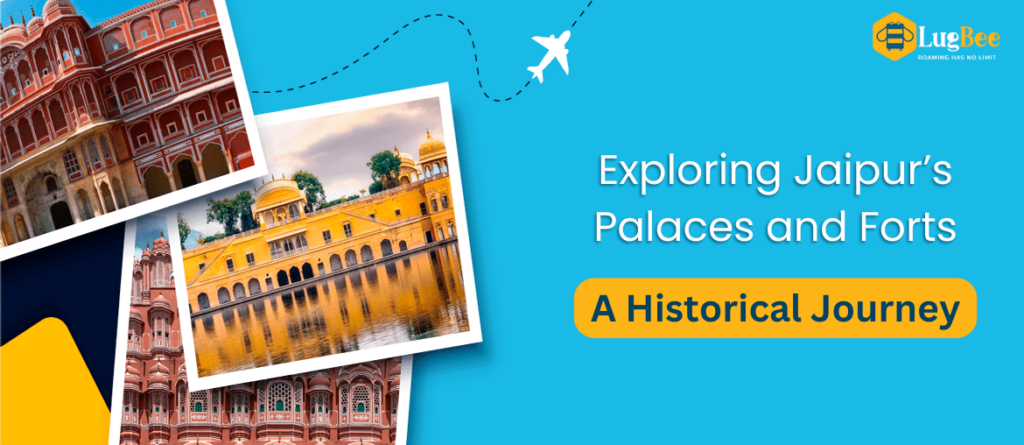Jaipur, the vibrant capital of Rajasthan, earns renown for its rich cultural heritage and architectural marvels. Known as the “Pink City,” Jaipur offers a treasure trove of historical palaces and forts that reflect the grandeur of India’s royal past. This blog takes you on a journey through some of Jaipur’s most iconic palaces and forts, unveiling their historical significance and architectural splendor.
1. Amber Fort: A Majestic Entrance
Perched on a hilltop, Amber Fort is one of Jaipur’s most famous landmarks. This fort combines Hindu and Mughal architectural styles and is a prime example of the grandeur of Jaipur’s palaces. Built in the 16th century by Raja Man Singh I, Amber Fort’s imposing walls, intricate mirror work, and lush courtyards exemplify the opulence of Jaipur’s palaces. Don’t miss the Sheesh Mahal (Mirror Palace), where artisans have adorned the walls with dazzling mirrors to create a mesmerizing effect.
Must-See: The main entrance, Suraj Pol, and the beautifully decorated Diwan-e-Aam (Hall of Public Audience) are highlights of this remarkable Jaipur palace.
2. City Palace: A Regal Abode
Located in the heart of Jaipur, the City Palace complex was built by Maharaja Sawai Jai Singh II, the founder of Jaipur. This sprawling palace complex is a blend of Rajput and Mughal architecture, featuring exquisite courtyards, gardens, and halls. The City Palace is one of the most significant Jaipur palaces, offering a glimpse into the opulent lifestyle of the royal family. The Chandra Mahal, one of the main attractions, showcases the grandeur of Jaipur’s palaces.
Must-See: The Mubarak Mahal (Welcoming Palace) is a stunning example of Jaipur’s architectural splendor, an essential part of the palace complex.
3. Hawa Mahal: The Palace of Winds
Hawa Mahal, or the Palace of Winds, features a unique façade with 953 windows, known as jharokhas. Built in 1799 by Maharaja Sawai Pratap Singh, this five-story palace allowed royal women to watch street festivities privately. The pink sandstone façade and intricate latticework make Hawa Mahal a photographer’s delight and an iconic Jaipur landmark.
Must-See: The view from the top floor of this stunning Jaipur palace offers panoramic vistas of the bustling city below.
4. Jal Mahal: The Water Palace
Nestled in the centre of Man Sagar Lake, Jal Mahal is an exquisite example of Rajput architecture. Originally built as a hunting lodge by Maharaja Sawai Jai Singh II, this palace seems to float on the lake’s surface, surrounded by picturesque hills. Although the palace restricts access, the view of Jal Mahal from the lake’s edge enchants visitors. This unique Jaipur palace stands out for its serene setting and architectural beauty.
Must-See: The palace’s reflection in the lake, especially during sunrise or sunset, highlights the enchanting allure of this Jaipur palace.
5. Jaigarh Fort: The Fort of Victory
Jaigarh Fort, also known as the Fort of Victory, stands out for its impressive fortifications and panoramic views of the surrounding landscape. Built by Maharaja Sawai Jai Singh II, the fort houses the world’s largest cannon on wheels, Jaivana. The fort’s architectural prowess and historical significance make it a notable landmark in Jaipur. While Jaigarh Fort is not strictly a palace, it complements the rich history of Jaipur’s palaces with its grandeur.
Must-See: The cannon, the watchtower, and the panoramic views of the Amber Fort are key highlights near this grand fortification. Additionally, the surrounding hills enhance the fort’s impressive features.
6. Nahargarh Fort: The Retreat of Royals
Nahargarh Fort, which Maharaja Sawai Jai Singh II built as a retreat, overlooks the city of Jaipur. Its charming architecture and serene surroundings make it a popular spot for sunset views. The fort’s vibrant frescoes and quaint rooms offer a glimpse into the leisure pursuits of the royal family. Adding to the rich tapestry of Jaipur’s palaces.
Must-See: The sunset view from the fort’s terrace and the beautiful frescoes in the palace highlight the relaxed elegance of this Jaipur palace retreat.
Best Time to Visit Jaipur Palaces for Sightseeing and Cultural Tours
The best time to visit Jaipur is during the cooler months from October to March, During this period. Weather is pleasant, daytime temperatures ranging from 15°C to 25°C (59°F to 77°F), making it ideal for exploring Jaipur’s palaces and other outdoor attractions.
- October to November: The weather starts to cool down after the hot summer months, and the city is lively with festivals and events.
- December to February: These months offer the most comfortable temperatures and clear skies, perfect for sightseeing and cultural tours of Jaipur’s palaces.
Avoid visiting during the summer months (April to June) when temperatures can soar above 40°C (104°F). Consider traveling during cooler periods when the heat can be less intense. The monsoon season (July to September) brings heavy rainfall and humidity, which can disrupt travel plans and outdoor activities.
How LugBee Can Help You
Exploring Jaipur palaces and forts can be an exciting adventure. managing your luggage can sometimes be a hassle. That’s where LugBee comes in. Our luggage storage service offers a convenient solution. This allows you to store your bags securely while you explore Jaipur’s historical treasures.
Benefits of Using LugBee:
- Convenience: Drop off your luggage at a LugBee location and explore Jaipur’s palaces hands-free.
- Security: We store your belongings safely in secure locations, giving you peace of mind.
- Flexibility: With multiple storage options and flexible timings, you can enjoy your visit to Jaipur’s palaces without worrying about your bags.
- App Experience: For an even better experience, download the LugBee app to manage your luggage storage with ease.
Make the most of your historical journey through Jaipur’s palaces and forts with LugBee’s hassle-free luggage storage service. Enjoy every moment of your exploration without the burden of managing your belongings.
Happy exploring!
